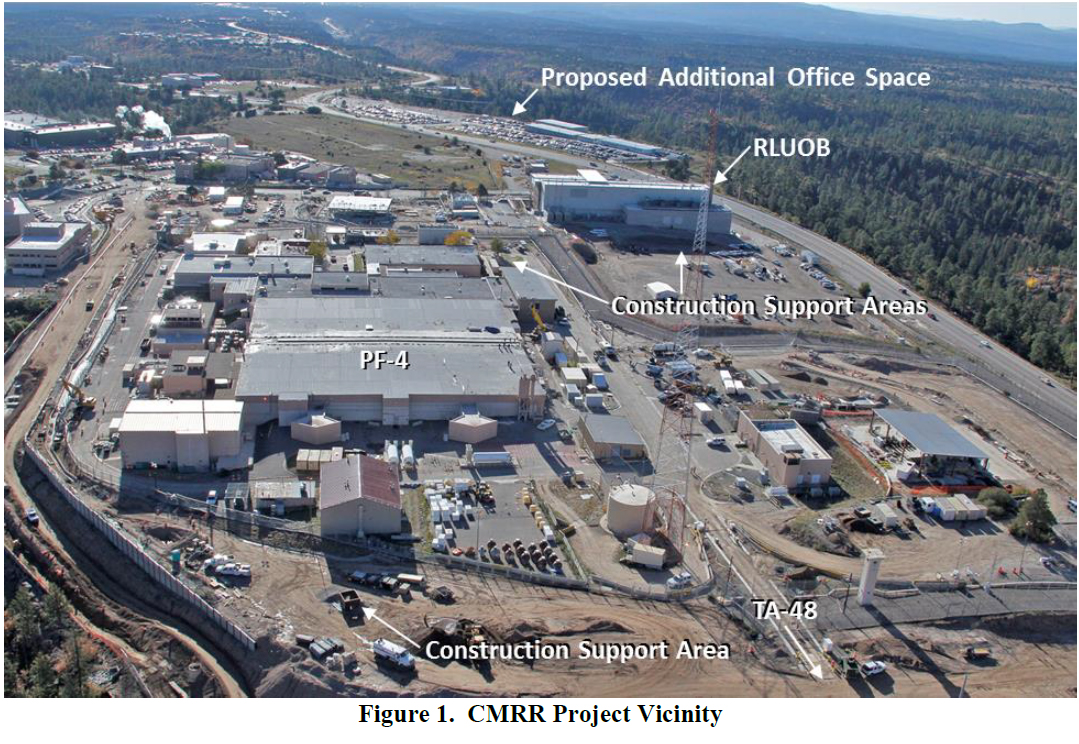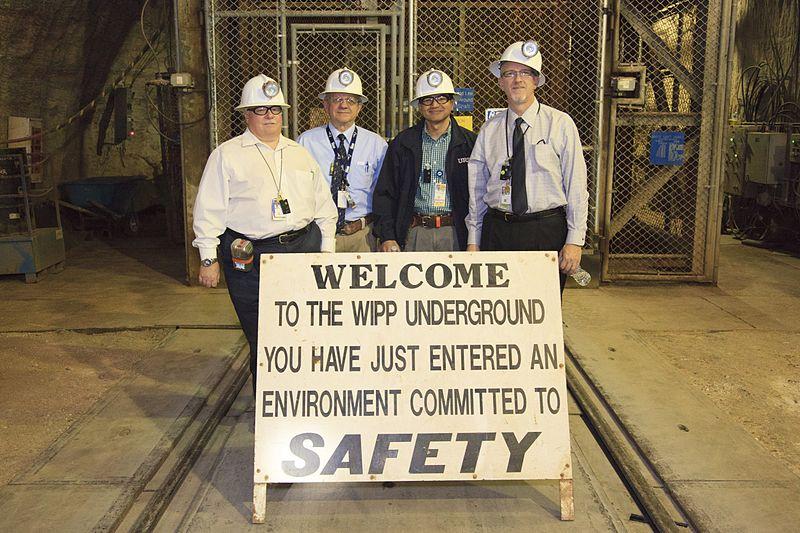
Proposed expansion for uranium pit production.
Costs Rise, Schedules Lengthen, Waste,
Safety, Transportation Issues Unresolved
Greg Mello / Los Alamos Study Group
ALBUQUERQUE, NM (August 23, 20230 — Two days ago, the Unitarian Congregation of Taos was the 102nd organization or business to endorse the “Call for Sanity, Not Nuclear Production.” Some 477 individuals have also signed on so far. The list of endorsers is gradually growing.
These groups and individuals, in the words of the “Call”:
- Oppose plutonium warhead core (“pit”) production at LANL first and foremost, but also elsewhere.
- Oppose the design, testing, and production of new and “upgraded” nuclear weapons.
- Prioritize removal and disposal of… legacy plutonium waste from LANL over-production of additional nuclear waste from nuclear weapons. [An outdated waste quantity has been removed here.]
- Choose human security, community resilience, and environmental protection over nuclear weapons production and our bloated military…We can no longer delay. We must use every opportunity, at every level of government, to prioritize human needs, invest in our communities, and build a more just and sustainable society. [An outdated budget comparison is omitted here.]
The “Call for Sanity” updates and brings into sharper focus an earlier “registry of resistance” from the 2005-2008 period, by emphasizing first and foremost opposition to pit production at Los Alamos National Laboratory (LANL), at which the National Nuclear Security Administration (NNSA) seeks to initiate pit production more than a decade prior to planned pit production at the Savannah River Site (SRS), where a larger, enduring facility is to be built using an uncompleted plutonium facility, designed and built to modern safety standards.
That earlier “Call for Nuclear Disarmament” began with a demand to “Stop the design and manufacture of all nuclear weapons, including plutonium bomb cores (‘pits’) at Los Alamos and elsewhere” (emphasis added).

J. Robert Oppenheimer and other members of the A-bomb team.
The extensive list of endorsers included hundreds of organizations, businesses, and religious organizations, including the members of the New Mexico Conference of Churches and many national and international religious organizations. (That Call was not open to individual signers.)
These expressions of opposition to building a new “right-sized” “Rocky Flats” plant were supported by a number of local government resolutions in New Mexico.
The City Council of Santa Fe unanimously opposed pit production at LANL, without conditions, four times (2003-64, passed Aug 13, 2003; 2005-39, passed Apr 13, 2005; 2006-104, passed Aug 28, 2006; 2008-17, passed Feb 13, 2008). Subsequent resolutions (2017-76, Oct 25, 2017; 2021-10, Feb 10, 2021) requested suspension of “expanded” pit production (the meaning of which is unclear) “until all nuclear safety issues are resolved, as certified by the independent Defense Nuclear Facilities Safety Board” (a condition for which no legal mandate exists).
The Town of Taos and Taos County (Joint Resolution 08-24 & 08-27, Apr 30, 2008) objected to “the expansion of nuclear weapons activities at the Los Alamos National Laboratory, including further increased plutonium pit production.” Again the Town of Taos requested, on May 20, 2019, that the Department of Energy “halt all nuclear weapons production activities at LANL, including expanded plutonium pit production…”(emphasis added).
Needless to say, the County of Los Alamos, which is currently gaining tens of millions annually in gross receipts taxes from pit production, endorsed pit production (Resolution 18-04, Feb 27, 2018).
These expressions of opposition from the grassroots, from religious organizations, and from local governments were at one time joined by opposition from New Mexico’s most senior elected officials and from LANL itselfand from the University of California academic senate (UC is still a partner in LANL management).
Recently, Santa Fe Archbishop Wester, following the leadership of Pope Francis, has been outspoken in his support for nuclear disarmament. Pope Francis:
“In a world where millions of children and families live in inhumane conditions, the money that is squandered and the fortunes made through the manufacture, upgrading, maintenance and sale of ever more destructive weapons are an affront crying out to heaven,” he said…”The use of atomic energy for purposes of war is immoral,” he said…”As is the possession of atomic weapons.”
While Archbishop Wester has not specifically condemned preparations for pit production in his Archdiocese, or called for anything beyond “mutual nuclear disarmament” (which is also the frequently repeated, official position of the US government) and does not actually condemn the work of employees at the nuclear laboratories in developing and maintaining nuclear weapons (“[a]s long as they were saying this is part of a larger trajectory of getting rid of nuclear weapons”), the main effect his Pastoral Letter (“Living in the Light of Christ’s Peace: A Conversation Toward Nuclear Disarmament“) may be in the conversations he has initiated.
Meanwhile NNSA’s costs are rising, not just at LANL but everywhere, and project schedules are lengthening (“GAO assessment of major NNSA projects finds major cost, schedule overruns,” press release, Aug 17, 2023; “GAO: Lab faces four-year delay, cost growth for making nuclear bomb cores,” Santa Fe New Mexican, Aug 18, 2023).
We believe the delays identified by GAO are likely to be extended even further, as NNSA appeared to suggest in March (“Schedule for Nuclear Warhead Core (“Pit”) Production Slipping, Costs Increasing: NNSA’s Strategy is Failing,” Mar 22, 2023). The exact meaning of NNSA’s enigmatic statements about schedule and costs may remain obscure until baseline estimates become available, currently scheduled for the April-June 2025 timeframe (“CD-3”, p. 211).

As an aside, the Government Accountability Office (GAO), which requires up to a year to do a major study like its January 2023 review of pit production (“GAO: NNSA’s Huge Program to Build New Warhead Cores (“Pits”) Lacks Detailed Schedule, Budget, and Scope of Work,” press release, Jan 12, 2023) must “freeze” the data it uses months before publication, which in the case of NNSA can and often does result in reports which are somewhat out of date when published.
Just one week after GAO’s year-long study of pit production was published, NNSA revealed that a key element in its pit production strategy at LANL would be delayed four years (“Installation of “Base” Capability to Produce 30 Plutonium Warhead Cores (“Pits”) at Los Alamos To Be Delayed 4 Years, to 2030, press release, Feb 3, 2023; “Approval of Critical Decision-2/3 for Los Alamos Plutonium Pit Production Project 30 Base Equipment Installation Subproject and Approval of Project Execution Plan,” DOE memo, Jan 19, 2023), making GAO’s cost estimates of the week before obsolete.
The policy importance of LANL’s lengthening pit production schedule lies not just in the added costs and risks, but in the fact that the main raison d’ etre of the LANL production effort — as opposed to pit production technology preservation, demonstration, and training — lies in the speed with which initiation of production at LANL was once thought capable.
At present, reliable pit production at LANL cannot occur prior to installation of the equipment with which that reliability is to be achieved, which is scheduled to occur in the 4th quarter of fiscal year 2031, five years after the statutory deadline.
The at-best late, limited, and non-enduring production at LANL will, assuming it is successful at all, consume over half of NNSA’s projected pit production budget (“Pit Production Startup Costs By Site and Year,” May 11, 2023), while incurring competition for scarce resources and consequently delaying the larger, enduring, safer, SRS facility (“NNSA’s effort to restart plutonium warhead “pit” production will cost more than the Manhattan Project. Why is NNSA trying to build two pit factories at once — one that is adequate, and one that is not?,” May 27, 2023).
The other main significance of the LANL delays lies in the difficulties they objectively signal. A long list of key issues at LANL remain unresolved, from staffing, to transportation of workers, to safety, to competition for scarce floor space, and on to the perennial issue of nuclear waste, among others. To delve into each of these issues in depth would lengthen this press backgrounder excessively.

Study Group director Greg Mello:
“Despite the utter lack of any democratic fora in which it could be expressed, long-standing New Mexico opposition to a factory for plutonium warhead cores, which aims to enable a new generation of nuclear weapons, remains and is growing. The new pits LANL would make are not needed for any current stockpile weapon system, nor will they ever be needed for that purpose.
The entire LANL pit production program is superfluous. Every dollar spent at LANL on this program is wasted. Every drum of waste produced in the process need not have been produced. Every career spent making these pits, or supporting the work, is a career that could have been spent building a sustainable, moral, responsible future. The LANL pit production program is a symptom of pure arrogance, greed, and management failure at the highest levels of government.”
Contact
Los Alamos Study Group
2901 Summit Place NE
Albuquerque, NM 87106
505-265-1200 office
505-577-8563 cell
To subscribe to our New Mexico Activist Leaders listserve send a blank email here. To unsubscribe send a blank email here.
To subscribe to our Main listserve (less frequent) send a blank email here. To unsubscribe send a blank email here. Our blog: Remember your Humanity. Twitter: @TrishABQ—